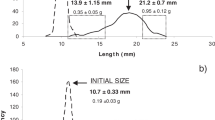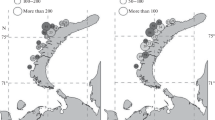Abstract
Populations of Fundulus heteroclitus (L.) at the beginning of a growth season in a New England salt marsh consist of 3 yearly age classes, with the 1-year-old class contributing most of the biomass. Calculation of production rates revealed that the young fish were the most active part of the population and that females were more productive than males. The entire population spent equal amounts of energy in growth and in metabolism. Including the young of the year, we obtained total production of 160 kg dry weight/ha, a value among the highest obtained for natural fish populations. About 5 to 15% of the production is available to predators. Rates of food consumption by F. heteroclitus are high enough to turn over the population of prey relatively often. Popululations of F. heteroclitus are thus capable of exerting an important influence on the abundance and distribution of their prey.
Similar content being viewed by others
Literature Cited
Aitchison, J. and J.A.C. Brown: The lognormal distribution, 196 pp. Cambridge: Cambridge University Press 1969
Allen, K.R.: The computation of production in fish populations. N.Z. Sci. Rev. 8, p. 89 (1950)
Bailey, N.T.J.: On estimating the size of mobile populations from recapture data. Biometrika 38, 293–306 (1951)
Birkett, L.: Experimental determination of food conversion and its application to ecology. In: Marine food chains, pp 261–264. Ed. by J.H. Steele. Berkeley: University of California Press 1970
Butner, A. and B.H. Brattstrom: Local movement in Menidia and Fundulus. Copeia 1960, 139–140 (1960)
Cassie, R.M.: Some uses of probability paper in the analysis of size frequency distribution. Aust. J. mar. Freshwat. Res. 5, 513–522 (1954)
Chapman, D.W.: Production in fish populations. In: The biological basis of freshwater fish production, pp 3–29. Ed. by S.D. Gerking. Oxford: Blackwell Scientific Publications 1967
—: Production. In: Methods for assessment of fish production in fresh waters, pp 182–196. Ed. by W.E. Ricker. Oxford: Blackwell Scientific Publications 1968 (IBP Handbook No. 3)
Darnell, R.M.: Organic detritus in relation to secondary production in aquatic communities. Verh. int. Verein. theor. angew. Limnol. 15, 462–470 (1964)
Eberhardt, L.L.: Population estimates from recapture frequencies. J. Wildl. Mgmt 33, 28–39 (1969)
Hald, A.: Maximum likelihood estimation of the parameters of a normal distribution which is truncated at a known point. Skand. Actuarietidskr. 32, 119–134 (1949)
—: Statistical theory with engineering applications, 783 pp. New York: John Wiley & Sons Inc. 1967
Harding, J.P.: The use of probability paper for the graphical analysis of polymodal frequency distributions. J. mar. biol. Ass. U.K. 28, 141–153 (1949)
Hoss, D.E.: Rates of respiration of estuarine fish. Proc. a. Conf. SEast. Ass. Game Fish Commn. 21, 416–422 (1967)
Huet, M.: The evaluation of fish productivity in fresh waters. Verh. int. Verein. theor. angew. Limnol. 15, 524–528 (1964)
Jeffries, H.P.: Fatty acid ecology of a tidal marsh. Limnol. Oceanogr. 17, 433–440 (1972)
Jones, R.: A review of methods of estimating population size from marking experiments. Rapp. P.-v. Réun. Cons. perm. int. Explor. Mer 155, 202–209 (1964)
Mann, K.H.: Energy transformation by a population of fish in the River Thames. J. Anim. Ecol. 34, 253–275 (1965)
Mathews, S.A.: The seasonal cyle in the gonads of Fundulus. Biol. Bull. mar. biol. Lab., Woods Hole 75, 66–74 (1938)
Nixon, S.W. and C.A. Oviatt: Ecology of a New England salt marsh. Ecol. Monogr. 43, 363–398 (1973)
Prinslow, T.E., I. Valiela and J.M. Teal: The effect of detritus and ration size on the growth of Fundulus heteroclitus (L.). J. exp. mar. Biol. Ecol. 16, 1–10 (1974)
Ricker, W.E.: Production and utilization of fish populations. Ecol. Monogr. 16, 374–391 (1946)
Vince, S., I. Valiela, N. Backus and J.M. Teal: Predation by the salt marsh killifish Fundulus heteroclitus (L.) in relation to prey size and habitat structure: consequences for prey distribution and abundance. J. exp. mar. Biol. Ecol. 23, 255–266 (1976)
Winberg, G.G.: Rate of metabolism and food requirements of fishes. [In Russ.] Nauch. Trudy belorussk. gos. Univ. V.I. Lenin (Minsk) 1–253. [Transl. Fish. Res. Bd Can. 194 (1956).]
Author information
Authors and Affiliations
Additional information
Communicated by M.R. Tripp, Newark
Contribution No. 3721 from the Woods Hole Oceanographic Institution.
Rights and permissions
About this article
Cite this article
Valiela, I., Wright, J.E., Teal, J.M. et al. Growth, production and energy transformations in the salt-marsh killifish Fundulus heteroclitus . Marine Biology 40, 135–144 (1977). https://doi.org/10.1007/BF00396259
Accepted:
Issue Date:
DOI: https://doi.org/10.1007/BF00396259




